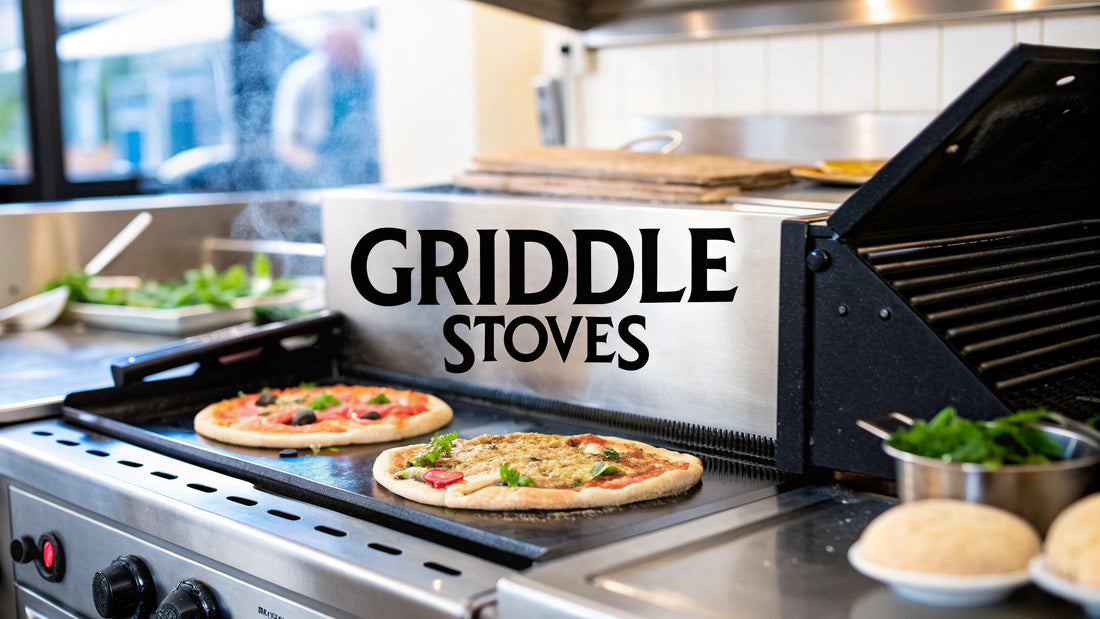
Choosing Kitchen Stoves with Griddle for Your Pizzeria
Share
A versatile kitchen stove with a griddle is so much more than another cooking appliance; it’s a full-blown workstation that brings your entire prep line together. For pizzerias, this means you can grill toppings, toast sandwich buns, and cook up sides on a single piece of equipment—right alongside your pizza prep tables. When combined with well-organized pizza prep tables, these multipurpose stoves ensure seamless topping assembly and pizza customization, dramatically increasing efficiency during a chaotic dinner rush.
Why Griddle Stoves Are a Game Changer for Pizza Kitchens
Imagine being able to streamline your whole pizza prep area. Instead of juggling a dozen pans on crowded burners or dedicating a separate flat-top for your sides, a kitchen stove with a griddle consolidates everything. This is a huge advantage for modern pizzerias that are looking to do more than just sling pies.
The real power here is in its versatility. One minute, you’re searing chicken or caramelizing onions for a specialty pizza right on the flat-top; the next, you’re toasting garlic bread to golden perfection or sautéing a side of vegetables. Paired with optimized pizza prep tables, you can coordinate the flow from dough stretching to topping finish, expanding your menu without cluttering your kitchen with more gear.
Boosting Workflow and Menu Diversity
When you combine a griddle with traditional burners next to your pizza prep tables, you create an incredibly dynamic cooking station. This setup is perfectly suited for the fast-paced, high-pressure world of a pizza restaurant, where speed and consistency are everything. You can think of it as the central hub for anything that doesn't go directly into the pizza oven.
This efficiency is also what's driving some serious market growth. The global commercial griddle market, which includes these combo stoves, is on track to hit around USD 576.4 million in 2025. This is largely thanks to demand from quick-service spots that need to cook a lot of different things, fast. You can learn more about the commercial griddle market growth and see the full report.
This chart from Future Market Insights breaks down the projected growth in the commercial griddle market by region.
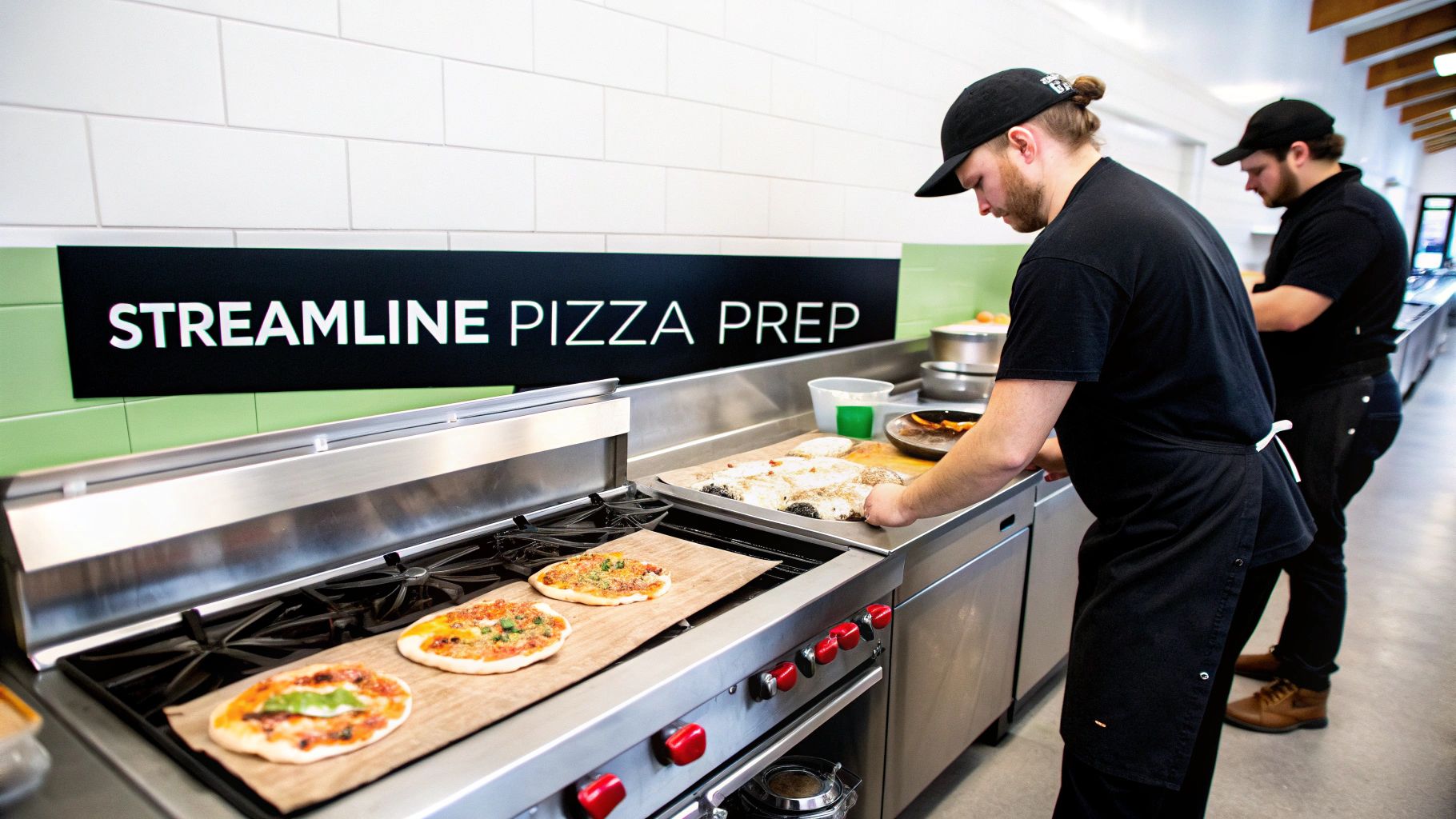
The data paints a clear picture: demand for this kind of equipment is on the rise, proving just how important it's becoming in commercial kitchens everywhere. For a pizzeria, this trend really highlights the strategic value of investing in a more versatile stove that sits right beside your pizza prep tables.
Practical Benefits for Your Pizzeria
Bringing a griddle stove into your kitchen has a direct impact on your day-to-day operations. It doesn't just improve your workflow; it empowers your kitchen staff to get more creative and productive—especially in tandem with your pizza prep tables.
- Expanded Menu Options: You can easily add profitable items like Philly cheesesteaks, gourmet grilled cheese sandwiches, or even breakfast without needing a whole separate flat-top grill.
- Faster Service Times: Cook multiple items at once. While your sauces are simmering on the burners, the griddle can be firing off toppings or sides, syncing perfectly with your prep table steps to cut down ticket times.
- Improved Kitchen Flow: By consolidating cooking tasks, you free up precious space around your pizza prep tables, creating a safer and much more organized work environment for your team.
In essence, a kitchen stove with a griddle acts as the ultimate support station for your pizza oven and pizza prep tables. It handles the crucial prep work that elevates a simple pizza menu into a full-service offering, setting the stage for a smarter and more profitable operation.
Understanding How Integrated Griddles Work
Under that flat steel surface lies a finely tuned cooking ecosystem. It’s not just a griddle—you’re looking at a landscape where heat is choreographed to handle multiple tasks at once.
Chefs often think in heat zones, much like lanes on a highway. One side blasts for quick sears—think charred bell peppers or perfectly browned chicken for your specialty pizza. The other side cruises gently, ideal for toasting garlic bread or keeping bacon warm without overcooking, all while your prep table operator readies the next pie.
Mastering these zones is what separates a true commercial powerhouse from a makeshift stovetop pan. It’s the secret to juggling toppings and sides smoothly during a busy dinner rush.
Heat Sources And Surface Materials
Every integrated griddle’s performance boils down to two things: how you heat it and what it’s made of. Match those elements to your menu, and you’ll hit both speed and consistency every time.
- Gas Griddles: Ignite and go. These units respond in a heartbeat, letting you switch from delicate vegetables to a full-on protein sear with a simple twist.
- Electric Griddles: Dial in a steady temperature and it stays put. Perfect when you’re stacking on dozens of uniform toppings and need even heat from edge to edge.
Let’s break down how these two power platforms differ in four key areas:
Gas vs Electric Griddle Stoves
| Feature | Gas Griddle | Electric Griddle |
|---|---|---|
| Performance | Rapid heat-up and instant temperature changes | Consistent, even warmth across the entire top |
| Installation Needs | Requires gas line hookup and proper ventilation | Needs a dedicated high-amp electrical circuit |
| Energy Use | Higher BTU output, variable efficiency | More efficient for long, steady holds |
| Maintenance | Burner cleaning, occasional flame adjustment | Element checks and surface calibration |
Each style has its place. If you need lightning-fast response for varied dishes and quick topping assembly by the prep table, gas is your go-to. But if uniform heat for repetitive tasks like toasting pizza crust edges is your priority, electric is the steadier choice.
When it comes to the griddle surface, here’s what you’ll find:
- Steel: The workhorse of griddles—durable and versatile.
- Chrome-Plated: Less porous, so flavors stay distinct and cleanup is a breeze.
“Match the heat source and surface to your menu.”
It’s a simple rule, but it makes all the difference in a high-volume pizza kitchen.
The commercial griddle market is set to reach USD 1.4 billion by 2025. That surge is driven by new features like IoT connectivity and touchscreen controls, which let you monitor grills remotely. For more on these emerging trends, check out the booming commercial griddle market.
With a handle on these basics, you’re ready to pick the perfect stove-and-griddle combo for your pizza prep tables.
Integrating a Griddle Stove into Your Kitchen Layout
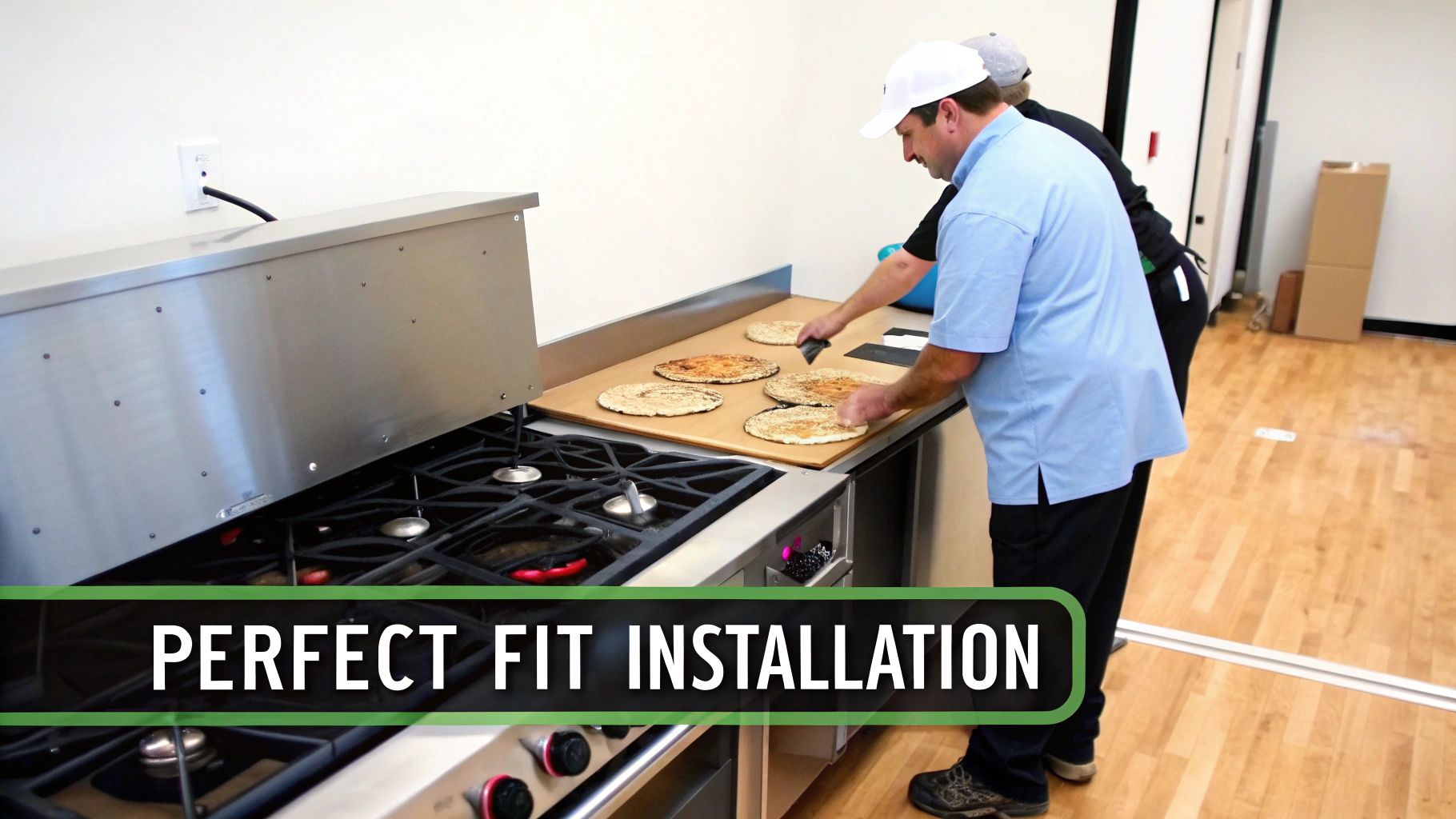
Adding a kitchen stove with a griddle isn't just about finding an empty spot on the floor. You need to think about how this new piece of equipment will play with your existing pizza prep tables and the overall flow of your kitchen. A little planning upfront prevents a lot of headaches and downtime later.
Before you even think about unboxing your new stove, grab a pencil and sketch out your current layout. Map out your hot zones, your main walkways, and all the clearances between equipment. You need at least 36 inches of clear space for staff to move safely and efficiently between the griddle and prep tables.
Planning Space Around Prep Tables
Think about the dance your crew does during a busy rush around the pizza prep tables. You don't want them bumping into each other.
- Keep aisles between your prep tables and the new griddle station at a minimum of 48 inches.
- Position splash guards strategically to protect other surfaces and, more importantly, your staff.
- Be careful with mobile prep carts. They're useful, but they can quickly turn a hot zone into an obstacle course.
For a deeper dive into making your kitchen flow smoothly, check out our guide on commercial kitchen layout design.
Once you've got your spacing figured out, it's time to look at the guts of the operation: the gas and electrical hookups that will keep your burners firing on all cylinders.
Verifying Hookups and Ventilation
This is not a DIY job. Hire licensed professionals to inspect your gas pressure and confirm your electrical circuits can handle the new load. An underpowered line might seem fine at 3 PM, but it can choke your performance right in the middle of the dinner rush.
Proper hookups are non-negotiable. They're about safety and the consistency of your service.
Don't forget about ventilation. Your commercial hood vents need to pull a minimum of 1500 CFM per foot to handle the grease and smoke. This keeps the air clean and prevents a greasy film from building up all over your pizza prep tables.
To make sure your new griddle stove is a perfect match for your space, using an appliance sizing guide is a crucial step for a seamless fit.
Scheduling and Safety Checks
The last thing you want is to shut down your kitchen during peak hours. Coordinate the installation for a slow period, like a weekend or early in the morning before the ovens are even warm. A little coordination keeps all the different tradespeople on the same page.
| Task | Party | Duration |
|---|---|---|
| Remove old stove | General contractor | 2 hrs |
| Install gas line | Licensed plumber | 3 hrs |
| Wire electrical circuit | Certified electrician | 2 hrs |
| Tie-in ventilation | HVAC specialist | 2.5 hrs |
| Final inspection | Health inspector | 1 hr |
After everything is hooked up, do a quick "flour test" to see how your new griddle heats. Just sprinkle a light layer of flour across the surface and watch how it browns. If you see a nice golden ring in about 90 seconds, you've got a balanced temperature. It’s a dead-simple way for your staff and those working pizza prep tables to learn the hot spots and adjust on the fly.
Troubleshooting Installation Issues
Even with the best planning, sometimes things go wrong. You might discover misaligned gas connectors or find out your floor isn't perfectly level. I once saw a pizzeria discover a 0.5-inch gap under their new griddle. A few stainless steel shims leveled it out and got them back in business safely.
Keep an eye out for these common gremlins:
- A loose gas fitting that causes the flame to flicker.
- Ventilation that isn't quite strong enough, leading to a smoky kitchen.
- Circuits that keep tripping breakers when you're busiest.
- An unlevel griddle surface that causes oil to pool and food to cook unevenly.
Catching these issues early is key to keeping your pizza line from grinding to a halt.
Coordinating Staff Training
A perfect layout doesn't mean much if your team doesn't know how to use the new gear. Schedule a quick walkthrough to show everyone the heat zones, the safety cut-offs, and the daily checks—especially those prepping toppings at the pizza prep tables.
I like to use an analogy: tell them to think of the burner controls like volume knobs. The chef is the DJ, dialing in the perfect temperature for each zone. It helps them get the feel for it without just guessing during a rush.
- Run a timed drill grilling some sample toppings.
- Watch for flare-ups and go over your grease management plan.
- Have different team members work on the griddle to build confidence and versatility.
Proper training is what turns a piece of equipment into a real asset. It empowers your staff to get the most out of your new kitchen stove with a griddle, day in and day out—right alongside your pizza prep tables.
Essential Maintenance for Lasting Performance
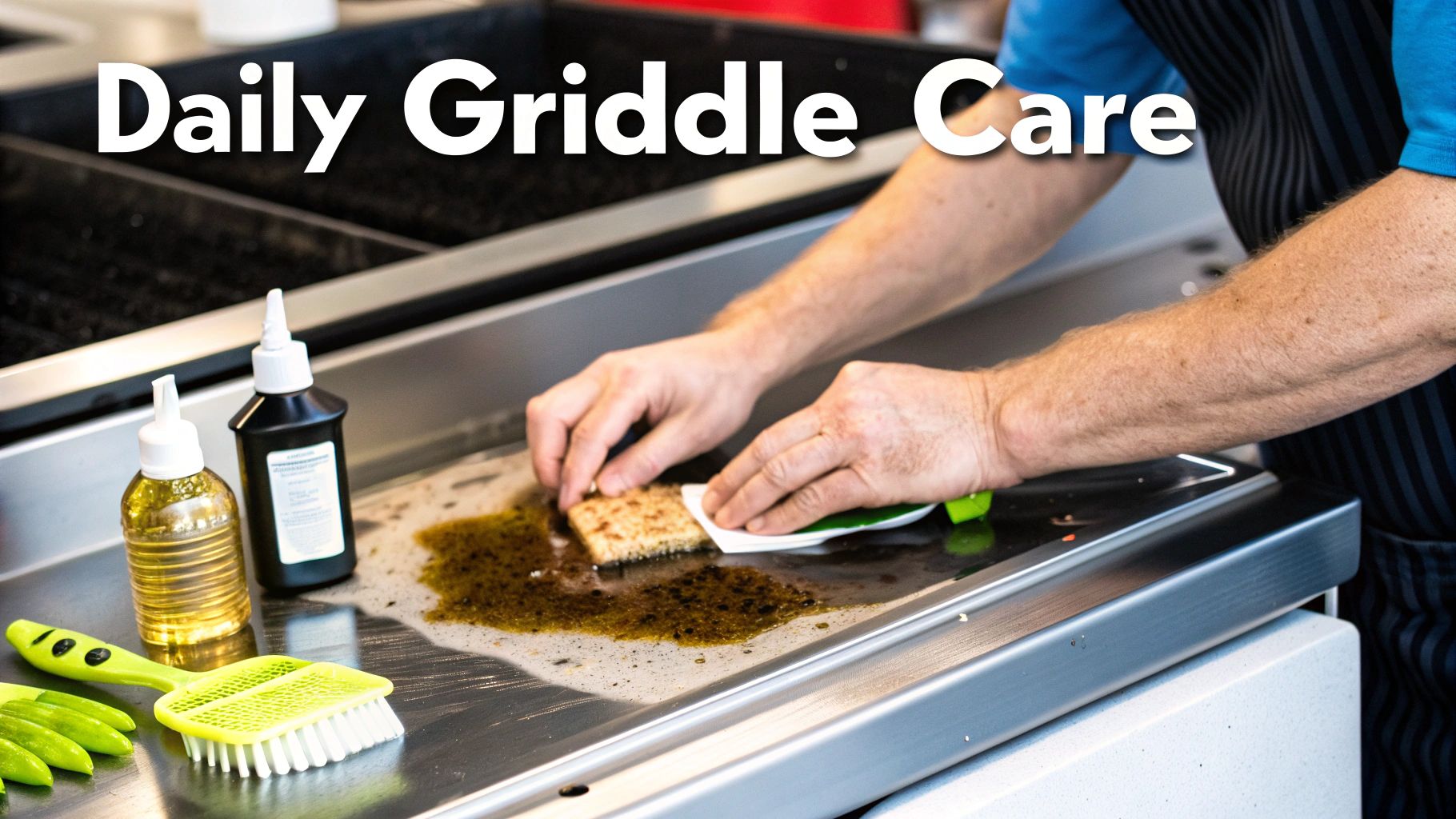
In a busy pizzeria, your equipment's reliability is everything. A kitchen stove with a griddle that goes down during a Friday night rush isn't just a headache; it's lost revenue. The real secret to keeping your griddle stove in peak condition isn't some complex service plan—it's consistent, proactive maintenance.
This isn't about spending hours deep cleaning every week. It's about building simple, effective habits into your daily, weekly, and quarterly routines. A few dedicated minutes of care each day can save you from costly repairs and the nightmare of unexpected downtime, a lesson many seasoned kitchen managers have learned the hard way.
The Daily End-of-Day Ritual
The most important maintenance you'll do happens right after closing time. A simple end-of-day wipe-down is your first line of defense against the grease and carbon buildup that causes uneven heating and can ruin the flavor of your food.
Think of it just like wiping down your pizza prep tables—it's a non-negotiable part of your closing checklist. While the griddle is still warm (but not scorching hot!), use a griddle scraper to push any debris into the grease trap. Follow that up with a quick wipe using a damp cloth and a food-safe cleaner.
"A clean griddle at closing time is a gift to your morning crew. It sets the tone for a smooth, efficient start and ensures the first order of the day tastes just as good as the last."
This simple act stops grease from hardening overnight, which can turn a five-minute task into a thirty-minute battle with a scouring pad. It also gives you a quick moment to visually inspect the surface for any new dings or issues.
Weekly and Quarterly Care Routines
Going beyond the daily wipe-down, setting aside a little extra time each week and quarter will massively extend the life of your equipment. These deeper checks help you catch small problems before they turn into major failures.
Weekly Maintenance Checklist:
- Empty and Clean the Grease Trap: Don't let this thing overflow. A full grease trap is a serious fire hazard and can create some pretty unpleasant odors in your kitchen.
- Inspect Burner Ports (for Gas Models): Look for clogged ports that can lead to uneven flames. A simple brush or pin can clear away debris and get your heat distribution back on track.
- Check for Leaks: Do a quick visual inspection of all gas lines and connections. If you smell gas, that's an immediate red flag that requires professional attention, no questions asked.
Quarterly Deep Dive:
- Calibrate Thermostats: Over time, thermostats can drift and lose their accuracy. Use an infrared thermometer to check the surface temperature against the dial setting and adjust it if needed.
- Thorough Sanitization: A deep clean with the right sanitizer is crucial for food safety. If you need a refresher, you can learn about the three types of sanitizer solutions that are most effective for a commercial kitchen.
- Inspect Electrical Components: On electric models, check for any frayed wires or loose connections.
Seasoning for a Non-Stick Surface
For any griddle made of cast iron or steel, proper seasoning is everything. This isn't just about cleaning; it's about creating a natural, non-stick surface that actually gets better every time you use it.
After cleaning the griddle, apply a very thin layer of cooking oil across the entire surface. Then, heat it until it just starts to smoke slightly. This process, called polymerization, creates a protective, slick layer that prevents rust and helps food release easily. A well-seasoned kitchen stove with a griddle is a true joy to cook on, ensuring toppings slide right off without a fight, making pizza prep alongside your tables faster and cleaner.
Key Features To Look For When Buying Your Griddle Stove
Choosing a griddle stove is more than finding a unit that fits your budget and kitchen footprint. In a busy pizzeria, the right stove becomes a teammate—boosting speed, consistency, and even the range of dishes you can pull off. Pick poorly, and you’ll feel the pinch on your busiest nights.
Think of it like selecting tires for a race car. You want components built for sustained, high-speed performance—not a leisurely Sunday drive.
Performance And Heat Management
When tickets fly in, you need two things: rapid heat recovery and precise temperature control.
- Rapid Heat Recovery: On a packed Friday night, you might jump from searing chicken to caramelized onions to toasting buns in seconds. A griddle that loses temperature between batches forces your line to slow to a crawl.
- Precise Temperature Control: Multiple heat zones let you sear one topping while gently warming bread at the other end. That flexibility means you can expand your menu without dragging in extra equipment.
A griddle’s ability to maintain consistent heat under relentless use is what separates professional gear from a residential plug-in.
If you want to compare models and see how their features stack up, explore our collection of commercial kitchen griddles.
Durability And Ease Of Maintenance
In a commercial kitchen, your equipment earns its keep every single day. Look for:
- Heavy-Gauge Stainless Steel construction that stands up to bumps, spills, and aggressive cleaning
- An efficient grease management system, with a large, easy-to-reach trap and deep troughs that whisk grease away from the cooking surface
Interestingly, this demand for powerful, yet user-friendly appliances isn’t limited to restaurants. In fact, the residential electric-griddle market is set to hit $500 million by 2025, underscoring a broad appetite for multi-purpose cooking tools. Discover more insights about consumer interest in electric griddles.
This chart drives home the point: home cooks and professional chefs alike prize equipment that packs power but stays simple to clean.
Size And Configuration
Finally, marry capacity with your kitchen’s real estate. Ask yourself: can you dedicate space to a floor-standing beast, or does a countertop model suit your workflow better?
- Floor Models: Best for high-volume pizzerias. They deliver extra cooking surface and often include storage beneath.
- Countertop Units: Perfect as a second station or for tighter kitchens. They sacrifice some power and capacity for flexibility.
Measure your footprints carefully and allow room for ventilation and staff movement around your pizza prep tables. And don’t skip the fine print—warranty length and local service availability can spell the difference between a minor hiccup and a full-blown kitchen shutdown.
Comparing Top Commercial Stoves with Griddles
Alright, now that we've covered the key features to look for, let's get into the good stuff: seeing what’s actually out on the market. Picking the right kitchen stove with a griddle isn't just a matter of checking boxes on a spec sheet. It's about finding a reliable partner for your pizzeria's daily grind—right next to your pizza prep tables when orders are flying.
This is the piece of equipment that directly impacts how smoothly you operate. The insights here come from real-world pizzeria owners who have put these units through hell and back, giving us a true picture of how they perform under pressure. We’re looking at heat consistency, cleanup, and overall value to help you find your perfect match.
Top Stoves with Griddle for Pizza Restaurants
The market is packed with options, and each has its own personality. You’ll find everything from compact units perfect for a tight kitchen to massive, high-output ranges built for insane volume. The trick is to match the stove’s capabilities to what your kitchen actually needs.
To give you a starting point, here’s a look at several popular models that consistently get high marks from pizzeria operators.
| Model | Type | Surface Area (sq in) | Heat Output | Control Interface | Price Range |
|---|---|---|---|---|---|
| Model A Heavy-Duty | Gas | 576 | 120,000 BTU | Manual Knobs | $2,500 - $3,500 |
| Model B Precision | Electric | 432 | 15 kW | Digital Touchscreen | $3,000 - $4,200 |
| Model C Compact | Gas | 360 | 90,000 BTU | Manual Knobs | $1,800 - $2,600 |
| Model D Hybrid | Gas/Electric | 600 | 110,000 BTU / 12 kW | Hybrid Controls | $4,500 - $6,000 |
| Model E Workhorse | Gas | 720 | 150,000 BTU | Manual Knobs | $3,800 - $5,500 |
While this table gives you a nice snapshot, the real story is how these machines handle the day-to-day chaos. A sky-high BTU output looks great on paper, but if that heat isn't consistent across the entire griddle, you’ll be serving up appetizers with burnt onions on one side and raw ones on the other.
Real-World Performance Insights
Beyond the spec sheets, the feedback from other owners is pure gold. For instance, one owner of a high-volume shop couldn't stop raving about the Model E Workhorse and its incredible heat retention. He told me, "Even when we're slamming it with cold ingredients during the dinner rush, it recovers its temperature almost instantly. It never slows us down."
On the flip side, an operator using the Model C Compact in a much smaller kitchen highlighted its efficiency and smart design. "It fits perfectly next to our main pizza prep table without creating a bottleneck," she explained. "It's not the most powerful, but it's incredibly reliable for our volume." This just goes to show that the "best" stove is completely relative to your kitchen's specific needs.
This example from a popular equipment supplier's website shows a few different ways these units can be configured for commercial kitchens.
As you can see, the layouts can vary quite a bit, which is great because it lets you find a design that perfectly matches your kitchen's flow next to your pizza prep tables.
Evaluating Heat Consistency and Cleanup
Two things that always come up in owner reviews are heat consistency and how easy the unit is to clean. A griddle with hot spots is a chef's worst nightmare, plain and simple. It leads to inconsistent food quality and a lot of frustration. Many owners I've talked to swear by thick, polished steel griddle plates, like the ones on the Model A Heavy-Duty, because they spread the heat far more evenly than thinner materials.
A common tip from seasoned chefs is to do the "water test" on a new griddle. Just sprinkle a few drops of water across the preheated surface. They should dance around and form little spheres. If they evaporate instantly in one spot but just sit there sluggishly in another, you’ve found an uneven heat zone.
When it comes to cleanup, a well-designed grease management system is a total game-changer. The Model B Precision, for example, gets high marks for its deep, front-facing grease trough and large trap. That design makes the end-of-night wipe-down significantly faster and less of a mess. As one manager put it, "Anything that saves us 15 minutes during closing is a huge win." That practical stuff is just as important as how well it cooks—especially when your staff is racing to finish cleaning both the griddle and pizza prep tables.
Which Griddle Stove Offers the Best Value?
Figuring out the best value isn't just about hunting for the lowest price. It’s about balancing the upfront cost with long-term reliability, performance, and how it impacts your daily operations. The initial investment in a high-quality kitchen stove with a griddle almost always pays for itself through less food waste, faster ticket times, and fewer maintenance headaches over its lifespan.
For many pizzerias, the sweet spot seems to be with models like the Model A Heavy-Duty. It brings together robust power and durability with a straightforward manual interface that’s far less likely to have electronic failures. It might not have all the bells and whistles of a digital model, but its reliability and consistent performance make it a trusted workhorse in thousands of kitchens, delivering exceptional value year after year.
Frequently Asked Questions
Got questions about stoves with griddles? You're not alone. Here are the answers to the questions we hear most often from pizzeria owners, covering everything from daily use to making the right long-term investment for your kitchen.
How Do I Keep Food From Sticking?
The secret to a slick, non-stick griddle isn't some fancy coating—it's all in the technique. The number one rule is to always preheat your griddle before you even think about adding oil. A simple water test is your best friend here: flick a few drops of water onto the surface. If they dance and sizzle before evaporating, you're good to go.
Patience is also key. When you’re searing off sausage or caramelizing onions for a new pizza special, the food will tell you when it’s ready. It naturally releases from the steel once a good crust has formed. Try to flip it too early, and you'll just end up with a stuck-on mess.
Choosing The Right Stove Size
Picking the right size kitchen stove with griddle really comes down to your menu and how many customers you're serving. A compact 24-inch unit could be the perfect fit for a smaller shop that just needs a griddle for toasting garlic bread or cooking up some sides at the pizza prep table.
But if you're a high-volume spot with a diverse menu, you'll want to think bigger. A 48-inch or even a 60-inch model will give you the real estate you need to keep up during the dinner rush without creating a bottleneck near your pizza prep tables.
This infographic breaks down the key features to consider as you scale up.
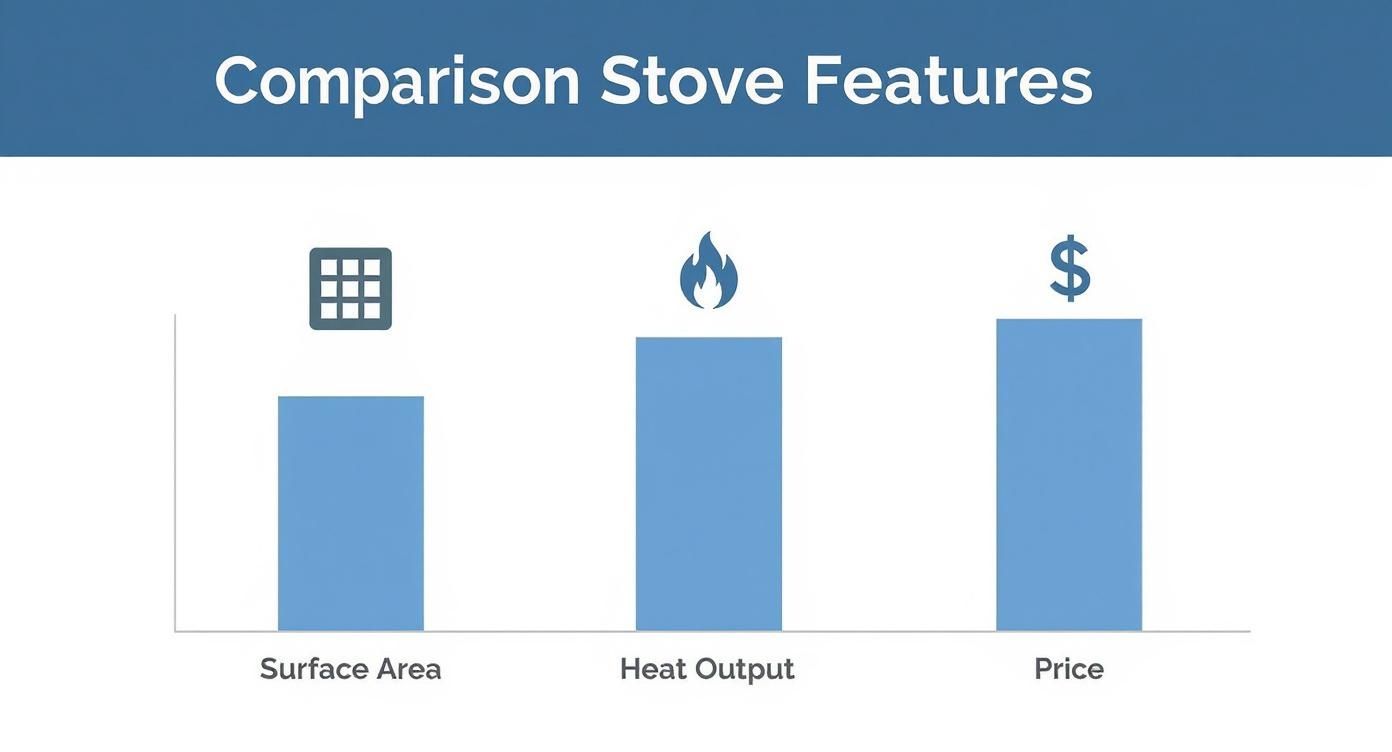
As you can see, it's a trade-off. More surface area and power come with a higher price tag, so it's all about figuring out what makes the most sense for your operation.
Gas Or Electric For A Pizzeria?
For the fast-paced world of a pizzeria, gas is almost always the answer. Gas griddles heat up in a flash and give you instant, precise control over the temperature. That responsiveness is critical when you're jumping from searing steak to lightly toasting buns in seconds—right in line with your prep table steps.
Electric models do offer incredibly even, consistent heat, which is great. But their slower response time can feel like an eternity when you've got a line of tickets and the pressure is on. During a chaotic dinner service, that lag can be a real drawback.
Ready to find the perfect griddle stove to complement your pizza prep tables? Pizza Prep Table offers a wide selection of commercial kitchen equipment to boost your pizzeria's efficiency. Explore our collection and find the ideal match for your kitchen at https://pizzapreptable.com.
